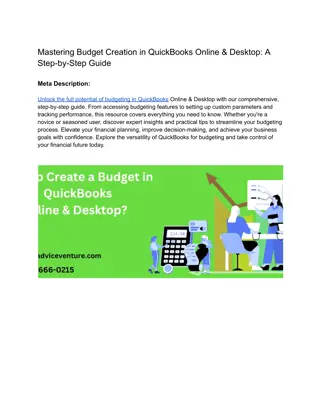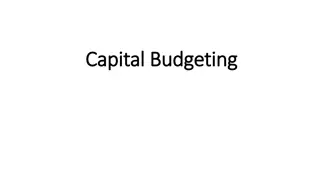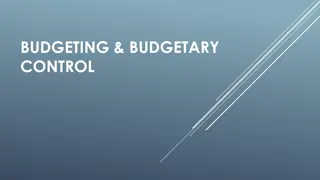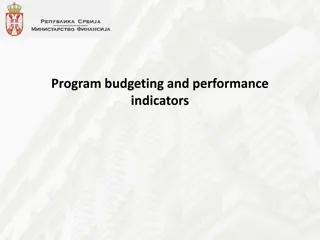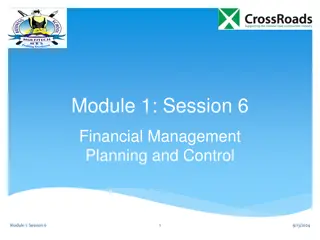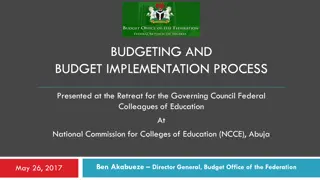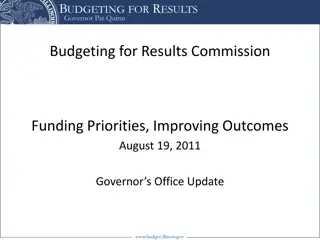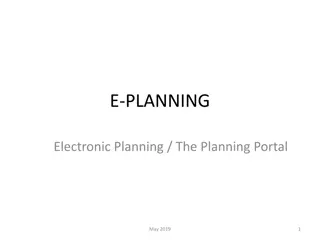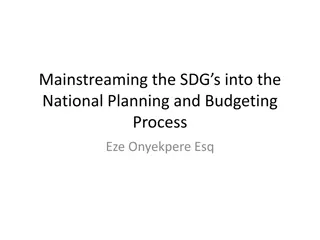
Financial Management and Budgeting Essentials
Explore the key concepts of budgeting, financial management, planning, organizing, staffing, directing, and controlling in organizations. Learn about the importance of planning, types of planning, and the purpose of budgeting as a tool for managing organizational funds effectively.
Download Presentation

Please find below an Image/Link to download the presentation.
The content on the website is provided AS IS for your information and personal use only. It may not be sold, licensed, or shared on other websites without obtaining consent from the author. If you encounter any issues during the download, it is possible that the publisher has removed the file from their server.
You are allowed to download the files provided on this website for personal or commercial use, subject to the condition that they are used lawfully. All files are the property of their respective owners.
The content on the website is provided AS IS for your information and personal use only. It may not be sold, licensed, or shared on other websites without obtaining consent from the author.
E N D
Presentation Transcript
BUDGETING AND FINANCIAL MANAGEMENT .
Management Functions Planning Organizing Staffing Directing Controlling
Planning Deciding in advance what needs to be done for the day, month, years ahead Charts the course for future action Facilitate use of time, activities and resources
Reasons for planning To focus attention on objectives To offset uncertainty and chance To gain economical operation To facilitate control
Types of Planning Standing Plan List of daily or standard activities Nursing care plan Used as a way of organizing time and activities
Types of Planning (continued) Strategic Planning Market and future oriented Provide a plan for the life of the entire organization Occurs at an administrative level or top management Includes in-depth analysis of factors within and outside the organization Involves: Methods to increase revenue Consolidate services Reduce loss of profit Provide income-producing services
Types of Planning (continued) Long-range Planning Provides direction for organizational growth Involves 1, 5, 10, 15, 20 year goals Administration meet to continually develop goals for the future SEE THE HANDOUNT
What is a budget? It is a tool for planning and controlling organizational funds. It is a formal written guideline describing organization s future goals expressed in financial terms within a set period of time. It is a detailed statement of estimated income and expenses. It is a historical record of the organization s activities during a given period.
Purpose of a Budget Planning document Incorporates financial data used by a department/organization Forecasts both receipts and expenditures. Financial data are used to keep system functioning.
Budgeting Concepts: The budget is integral to planning. It provides an orderly and rational framework for organizing effort; it serves as management tool for both directing and controlling effort. Financial management: Is defined as "a series of activities designed to allocate resources and plan for the efficient operation of the organization".
Factors influencing Budget planning: Economic environment, financial means Changing demands Availability of human resources Capacity of facilities Service costs/market price Other factors include consideration of organizational mission goals and strategic direction as well as the economic environment and the plans and objectives of other segments of the organization.
Nursing Budget Generating and controlling a divisional budget is a major responsibility of the nurse executive. To predict budget expenses for any anticipated period of time, the nurse executive needs to identify clearly three elements: The present activities of the nursing division The activities that the division plans to institute during the projected financial period Those activities the division plans to delete during the projected period.
.Systems of budget development 1. Centralized budgets: Are developed and imposed by the controller, administrator of the hospital, and the director of nursing services, with little or no consultation with lower-level managers. This is top-down approach leaves the implementers of the budget without autonomy or the right to appropriate or control expenses.
2. Decentralized budget: More and more health agencies are recognizing the value of having budgets prepared by those who must implement them. With decentralization the first-level manager (head nurse) becomes actively involved in the planning and budgeting process; autonomy, accountability, and authority are placed at the practitioner level.
Types of budgets Operational Budget: Includes services to be provided and goods the unit expects to consume or utilize during the budget period. For a nursing unit this covers the cost of salaries, fringe benefits, supplies, small equipment, and other miscellaneous items.
The Capital Budget This represents the projection of costs for major purchases or projects. Each institution has its own definition of what qualifies as a capital expense. Capital items usually include major architectural renovations, major technological equipment's, and fixed assets (furniture, buildings). Capital budgets are forecasted over a 3-year period; however they are reviewed and revised annually and as needs change. In preparing a capital budget, the nurse executive is required to document the need for most major items.
The budgetary process: Preparation of the budget begins several months before the end of each fiscal year to allow time for careful preparation. First: those involved with budget preparation review agency policies, standards, and objectives Second: the agency controller and director of nursing services prepare guidelines for the budget. Third: The first-level managers (head nurses) prepare the budget for their units based on past expenditures and predictions for the coming year.
Managing Financial Resources Financial management has a large scope, and has many interrelated activities. Preparing the budget is one of the last steps in handling finances. In health care institutions, the financial department coordinates financial operations throughout the entire organization or network.
Objectives of Financial Management Ensure the organization has an efficient and effective financial management structure supporting strategic objectives Establish a uniform set of internal financial controls throughout the organization Provide appropriate financial information to make timely decisions
Accounting Records and reports all financial transactions Generates the data for the budget Standard accounting Reports financial performance on a monthly, quarterly, or yearly basis Uses income statements, balance sheets, or cash-flow statements

